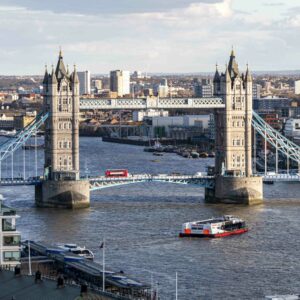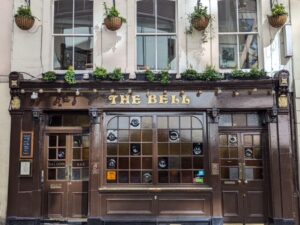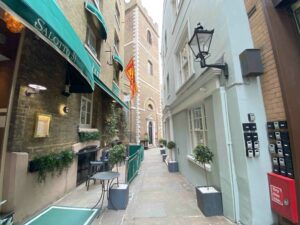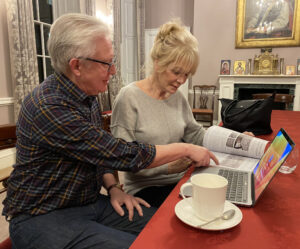If you want to explore the remains of Roman Londinium you’ll certainly find what you’re looking for if you poke about in the areas around Barbican or Tower Hill, but if you prefer to sightsee under cover – so handy on a rainy afternoon – here are the four main attractions in the City to head for, starting with the newest.
THE CITY WALL AT VINE STREET
12 Jewry Street, London, EC3N 2HT
A new centre has opened this summer at Vine Street close to the Tower of London. It houses – in great style – a section of the Roman City wall which, unusually has none of the usual medieval repairs. The wall was built around the city from 190AD but not discovered until 1979 having been lost from view, absorbed over time by workshops, homes and warehouses.
The wall’s original purpose has been lost in the midst of time, but it would appear it could well have been a defensive structure, as it was almost 4-6 metres high. It could also have enabled movement in and out of the City of Londinium to be more closely controlled, ensuring that any customs due could be collected. The wall was built from Kentish ragstone, arriving in the capital on the final leg of its journey along the River Thames.
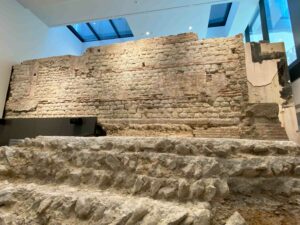
Get up close to this section of the wall – you can almost see the marks of the stone masons -and admire the building methods of these ancient workmen: courses of ragstone topped with two layers of roman tiles in order to ensure the stability of the stonework. One of the most exciting finds is the remains of a 4th century bastion.
The archaeologists have left the story of this wall’s history from the 2nd century AD up to the present day in situ, so we can also admire the 20th century steel structures that have supported the wall, and the infill of more modern brickwork that has played a part in its story.
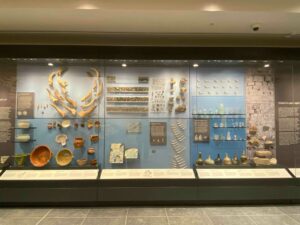
But this new exhibit reveals more than simply a very impressive section of the Roman wall. Displayed around the wall in chronological order, are fascinating artefacts discovered during the archaeological dig, which help to tell the story of the site over the centuries. Check out the animal horns, the shards of pottery (one showing the imprint of a curious cat) the mosaic pieces and much more. A fascinating case contains the contents of two cesspits belonging to two 18th century residents – next door neighbours, James Reynolds and Francis Joyce. It is revealing to see what ended up in these rather smelly pits. Here’s one hint- it looks as though 18th century inhabitants of London kept pet rabbits! All will be revealed on your visit.
And when you have finished admiring this impressive structure bring yourself right back to the 21st century with a cappuccino and a muffin at the Senzo café run from the same building. It’s open from 7.30-4.30pm during the week and 9-2 pm at weekends.
The gallery is open every day from until 9-6pm. Closed Bank Holidays. Entry to the gallery is from Jewry Street.
LONDON MITHRAEUM
12 Walbrook, London, EC4N 8AA
Another must-see site with numerous Roman artefacts on display is the London Mithraeum. Situated in Walbrook beneath the ultra-modern Bloomberg building, the remains of this mysterious temple to the god Mithras were discovered during post war excavations in 1954, and it’s been recognised as one of London’s most significant archaeological sites.
Constructed in the 3rd century AD, the London temple is one of around 100 mithrea known to have existed in the roman world, and while little is known about the mysterious rituals and beliefs involved, we do know that it was very much a masculine cult, attracting high ranking soldiers and merchants, and probably situated in a back garden out of public view.
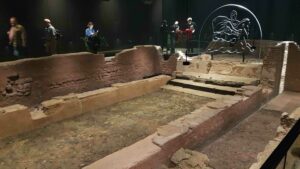
Visitors today descend underground to the reconstructed site of the temple where a sound and atmospheric light installation helps evoke the mystery of the cult of Mithras.
Some 14,000 artefacts were discovered during excavations and some 600 of these are on show in the ground floor gallery including the earliest written document from Britain.
The Mithraeum is open Tuesday – Sunday and is free to visit, but it’s recommended that you book online to ensure entry.
BILLINGSGATE ROMAN HOUSE AND BATHS
101 Lower Thames Street, London EC3R 6DL
Situated rather incongruously beneath an office block in Lower Thames Street, lie some of Roman Londinium’s most fascinating remains. The Billingsgate Roman House and Baths were discovered in 1848 during construction of the Victorian Coal Exchange. First built in AD 150 – the baths were in use right up until the 5th century AD. This is where Romans went, not to only to bathe, but exercise, socialise, gossip and do business deals.
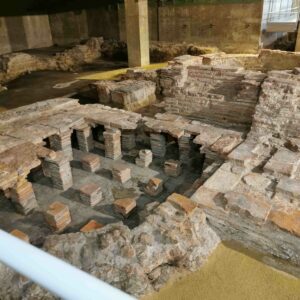
The House and Baths are open every Saturday from April to November. You’ll need to book a guided tour, and tickets (£10 or £8 concessions) must be booked advance. It’s well worth a visit.
LONDINIUM’S ROMAN AMPHITHEATRE
Guildhall Art Gallery, Guildhall Yard, London, EC2V 5AE
London’s Roman Amphitheatre caused huge excitement when it was discovered in 1988 during construction of the new Guildhall Art Gallery. Built sometime in the second century AD, it was large enough to seat over 6,000 spectators who were entertained with shows of wild animal baiting and gladiator combat.
Today, 20 feet below ground in the basement of the Art Gallery you’ll find the stone entrance tunnel, east gate, and arena walls, as well the extraordinarily well preserved drainage system.
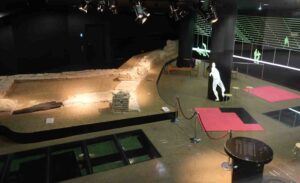
Also on display in the Gallery right now is the oldest document in the archive of the City of London Corporation – the charter of William l to the City of London in 1067, in which he guaranteed the collective rights of all the City’s inhabitants, thus awarding the city the special status it still enjoys today.
The Guildhall Art Gallery is free to enter and open daily from 10:30am to 4pm.
Authors: Jane Copland and Caroline Powell

